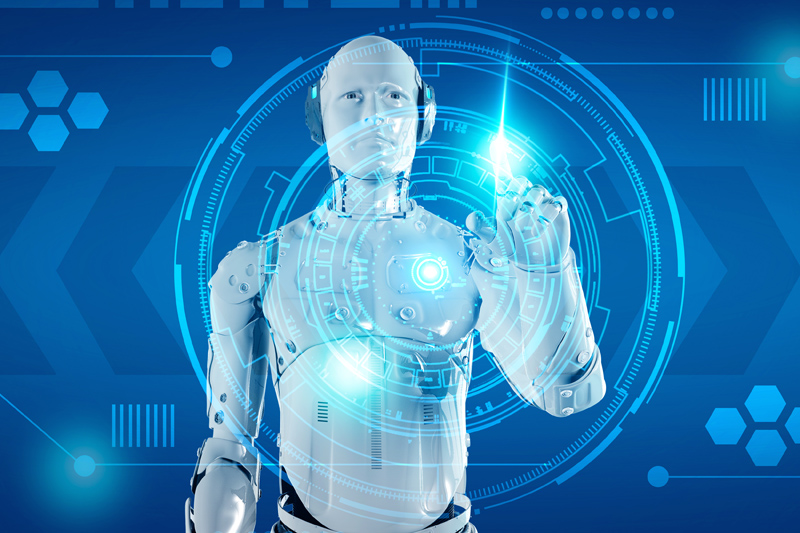

The emergence of artificial intelligence (AI) has given robots the ability to learn, adapt and make decisions autonomously, without the need for human intervention or pre-programmed instructions. AI technology gives robot algorithms the ability to analyze and understand data from the environment and take corresponding actions. These algorithms can be thought of as functioning similarly to the human brain, capable of perceiving information, finding patterns, and producing results. In addition, artificial intelligence (AI) also enables robots to interact with humans and other machines through the use of speech recognition and natural language processing technology.
Artificial intelligence in robotics is a fascinating field that merges two interrelated disciplines, artificial intelligence (AI) and robotics. It aims to create artificial intelligence robots capable of reasoning, learning, perception and decision-making, tasks that typically require human intelligence. Artificial intelligence involves developing software and algorithms for intelligent machine behavior, while robotics focuses on the design, manufacture and use of robots. When they are combined together, they form robotic artificial intelligence, which uses artificial intelligence technology to enhance robotic systems, increasing their capabilities and automation, allowing them to perform more complex and independent tasks.
Artificial intelligence has a variety of applications in robotics depending on the type, function, and goals of the robot.
Computer Vision: Analyzing and understanding visual data, including pictures and movies, is the focus of this field of artificial intelligence. With the help of computer vision, robots can measure distance, depth, and size, as well as detect and recognize objects, faces, gestures, and scenery around them. Computer vision is critical for tasks such as navigation and obstacle avoidance, as well as object recognition, tracking and manipulation.
Machine Learning: Developing algorithms that can learn from data and experience without explicit programming is the focus of the field of artificial intelligence. Thanks to machine learning, robots can now operate optimally, adapt to new environments, and solve problems that are too complex or dynamic for traditional approaches. Depending on the type and accessibility of data and feedback, machine learning can use supervised, unsupervised, or reinforcement learning methods. For tasks such as classification, clustering, regression, anomaly detection and control, machine learning is helpful.
Natural Language Processing: Natural language processing and creation, including speech and text, falls under this field of artificial intelligence. Natural language processing gives robots the ability to communicate with people and other machines by using natural language creation, interpretation, and translation methods. Activities such as conversational systems, information extraction, sentiment analysis, and human-computer interaction require natural language processing.
Deep Learning: Artificial neural networks, composed of multiple layers of connected nodes, are capable of learning complex non-linear patterns from large amounts of data and are the subject of this branch of machine learning. Deep learning enables robots to perform computer vision, speech recognition, image recognition, and natural language processing tasks that require high-level abstraction and generalization. Depending on the design and purpose of the network, convolutional, recurrent, or generative neural networks can also be used for deep learning.
Emotional Intelligence: Some robots are designed to sense and respond to human emotions. Emotional intelligence can enable robots to better understand the emotional state of human users and respond accordingly by analyzing facial expressions, voice intonation and other information.
Collaboration and swarm intelligence: Multiple robots can work together to complete more complex tasks. Collaborative and swarm intelligence technologies allow robots to share information, coordinate actions, and work together to solve problems.
Perception enhancement and sensor technology: Robots are usually equipped with various sensors, such as cameras, lidar, ultrasonic sensors, etc. Artificial intelligence can process and analyze the data provided by these sensors, allowing robots to better understand their surroundings.
Motion control and path planning: Through reinforcement learning and other control algorithms, robots can learn to perform complex actions and movements. Path planning algorithms allow robots to plan optimal paths to complete tasks, such as avoiding obstacles or navigating complex environments.
These applications enable robots to play a role in a variety of fields, including manufacturing, healthcare, service industries, the military, and more. Artificial intelligence gives robots more advanced intelligence and adaptability, allowing them to perform various tasks more flexibly and efficiently.
Artificial intelligence and robotics together bring many opportunities and difficulties to the development of future technology and society. Robots with artificial intelligence skills can perform tasks that humans cannot complete, such as space exploration, combat, life-saving, etc. However, AI robots can also pose dangers and ethical dilemmas. For example, they may displace human labor, cause accidents, or raise ethical questions about responsibility and accountability. Therefore, laws and norms that guarantee the safety, reliability, and fairness of these devices, as well as uphold human rights, dignity, and values, are needed to guide the development and use of artificial intelligence in robotics.
The above is the detailed content of Detailed analysis of how robots use artificial intelligence. For more information, please follow other related articles on the PHP Chinese website!
 Application of artificial intelligence in life
Application of artificial intelligence in life
 What is the basic concept of artificial intelligence
What is the basic concept of artificial intelligence
 How to register a business email
How to register a business email
 What are the advantages of the Spring Boot framework?
What are the advantages of the Spring Boot framework?
 Which is better to learn first, c language or c++?
Which is better to learn first, c language or c++?
 What to do if temporary file rename fails
What to do if temporary file rename fails
 Detailed explanation of nginx configuration
Detailed explanation of nginx configuration
 How to implement docker container technology in java
How to implement docker container technology in java




